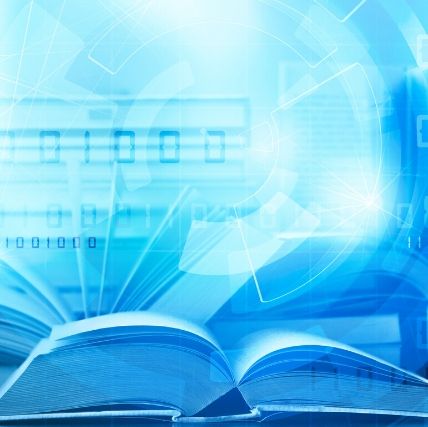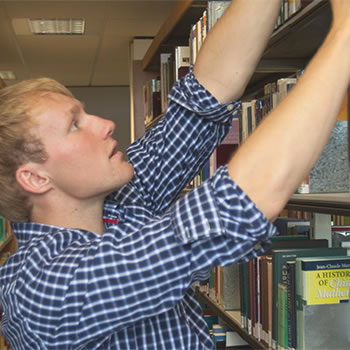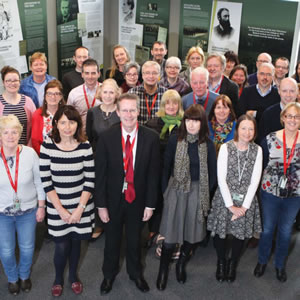- My Library Account
- Collections

Collections
The Library provides access to books, electronic resources, archives, special collections, and more to support your learning and research.
- Research

Research
The Library is committed to supporting your research needs with expert guidance and resources.
- Studying
- Academic Skills Service for Students
- Academic Writing Centre
- Assistive Technology Area
- Borrowing Limits, Lost Books & Fines
- Digital Literacy
- Equipment & More
- Group Study Rooms
- Library & IT Service Desk
- MakerSpace for Students
- Past Exam Papers
- Photocopying & Printing
- Shannon College Library
- Study Spaces
- Using Other Libraries

Studying
The Library has all the resources and supports you need to be successful in your studies at undergraduate and postgraduate level. Whether you're just starting your studies or working on your final project, we're here to help.
- Teaching

Teaching
We are here to help lecturers and academic staff deliver quality teaching and support their students' success.
- About

- Workshops & Events
Digital Preservation Policy
QA821 Digital Preservation Policy
General Principles of Preservation
- Retention: Material added to the Library’s collections are normally acquired with the intention that they will be retained in perpetuity.
- Access: Use of and access to the Library’s collections are the guiding purposes of its existence. Preservation ensures that material remains fit for use, even if legislation such as Copyright or Data Protection means that some material is embargoed from public use.
- Disaster preparedness: Ensuring contingency procedures are in place to prevent, and if necessary respond to and recover from emergency situations that may have an adverse effect on the Library’s Digital Collections.
- Financial support: Ensuring a proportion of the Library’s/University’s annual budget is allocated to supporting activities that ensure that the preservation policy can be implemented, including the Digital Repository, secure storage, and appropriate software and hardware.
- Standards: Best practice metadata, file format, and reference models are a vital element indeveloping reliable digital preservation procedures. We will be guided by the principles of reliable digital repositories in order to meet the commonly expected requirements of a Trusted Digital Repository. Certification systems such as the Trusted Repositories Audit & Certification (TRAC) or the Digital Repository Audit Method on Risk Assessment (DRAMBORA) can be used for guidance. We will work in accordance with published standards where they exist, to recognised 'best practice' where no standards exist, and to 'best effort' as a last resort.
- Monitoring and review of policy: The Digital Preservation Policy will be reviewed on a regular basis – at least every three years - to ensure that it:
- Addresses current internal strategic developments.
- Meets the needs of the collections it serves.
- Reflects appropriate national and international standards and changes in practice.
- Supports library staff responsible for collection development.
- Coverage of our Digital Preservation Activities
This policy governs the following Digital Collections:
- Digitised material: Digitised versions of analogue materials held by the Library, or material held by external organisations and digitised for the Library
- Born Digital Material: Digital resources without an analogue equivalent such as personal or organisational archives. We have one example of an archive that is entirely born digital (The One Foundation), and several examples of hybrid collections that include both paper and born digital material.
Commercially available electronic publications that the Library has acquired access to, that is stored on devices such as hard-drives and CD ROM.
The scope of the policy does not cover the management of records created by the staff of the University.
In the case of digital material, retention and preservation are co-dependent. To ensure sustainable access, preservation actions must begin at the beginning of the document’s life cycle, or at the time of acquisition (whichever is possible) to guarantee retention.
Preservation Policy for Digital Resources
Three types of strategies can be applied to safeguard digital assets: normalisation, migration and emulation. A common approach among institutions responsible for these materials is to use a combined approach, as no single approach is likely to guarantee the long-term survival of its digital material.
Focusing on retention of the original bit stream, format migration and normalisation – is preferred.
In practice this means:
- Normalising formats for digitisation using TIFF and PDF for images, WAV for audio and MPEG for moving image.
- Retention of original born digital formats in the digital object repository and where necessary, migration of material to a like current format.
- Where possible and necessary, migration of material to the best available current format. Tools for the migration and/or normalisation of data formats are constantly evolving.
The choice of tools for migration or normalisation for any one collection will be made on consideration of the following criteria:
- Availability of a tool, its cost and ease of use
- Ability to read data from the media on which it is stored
- Ability of a tool to be embedded in automated processes
- Volume of material requiring migration and/or normalisation
- Ability of a tool to accurately render significant properties in a migrated format
- Metadata
- Descriptive and administrative metadata, in accordance with published standards, is essential to managing the life cycle of our digital collections, for resource discovery, and for any potential collaborative efforts with other Institutions.
- Metadata will be stored and managed within the Library’s Management Systems, which are currently: CALM – archival descriptive metadata (ISADg/EAD), Islandora – (MODS and PREMIS), Aleph/Primo
Data Storage and Back-Up:
- Material will not be permanently stored on portable media. Inappropriate forms of portable media for long term storage would be floppy disc and other obsolete forms, SD storage cards, VHS, CD ROM, external hard drives. Obsolete hardware will not be preserved, on the grounds that it is economically unsustainable and technically challenging. The Library will make ad hoc use of hardware it already owns to facilitate the recovery of material from portable media.
- The Library has plans and processes in place to ensure that data held by Library systems is secure and can be recovered in the event of a disaster
Acquisition of Digital Material
- All incoming digital material delivered to the Library on portable media, e.g., USB hard drive, non-rewritable CD-ROMs, will be checked for viruses and malware. Infected material will be excluded from use on Library platforms until it has been rendered safe. Donor/creators will be informed if any virus is detected and will be invited to re-submit material.
- The Library has no preferred formats for the born digital material it acquires, but where practicable, will work with donors/creators in the acquisition of born digital material to ensure material is acquired in formats it has ‘high confidence’ of successful long term preservation in.
- Material that is transferred to the Library in a 'low confidence' format may be rejected by the Library. If material is accepted it may be subject to normalisation or migration, the loss of authenticity or functionality or to retention for a finite period in which it remains viable. The decision to accept material in a 'low confidence' format will depend on its relationship to other material already in collections, its value, the likelihood of recovering a meaningful and workable bitstream; the cost associated with recovery.
Download PDF copy of the policy: QA821 Digital Preservation Policy











